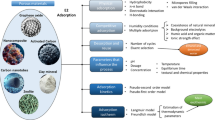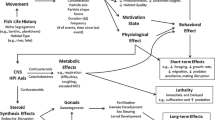Abstract
Due to increasing use and release, both multiwall carbon nanotubes (MWCNTs) and 17β-estradiol (E2) may co-exist and interact with each other in aquatic environments. However, little is known about their combined effects on non-target organisms, especially in the presence of other environmental factors. In this study, the interplay between MWCNTs and E2 in the early life stages of zebrafish was investigated, focusing on the alterations in estrogenic responses with and without other environmental factors. There were no significant differences in the hatchability, mortality, or physical development of zebrafish in any treatments. Compared with E2 exposure, the E2-induced estrogenic responses (vtg1, vtg3, and esr1 genes) in zebrafish were markedly reduced to baseline by the presence of MWCNTs in most cases, indicating a strong protective effect. Furthermore, this inhibitive effect was not significantly changed by the preloading of natural organic matter (NOM) on MWCNTs. Nevertheless, the addition of ammonia nitrogen in the mixtures of MWCNTs and E2 alleviated the protective effect of MWCNTs, resuscitating the E2-induced estrogenic responses in zebrafish. These findings highlight the influence of carbon nanomaterials on the bioavailability of co-contaminants in organisms. The widespread environmental factors in natural environments should also be taken into consideration when the combined toxicity of nanomaterials and contaminants is discussed.




Similar content being viewed by others
References
Al-Khateeb LA, Obaid AY, Asiri NA, Salam MA (2014) Adsorption behavior of estrogenic compounds on carbon nanotubes from aqueous solutions: kinetic and thermodynamic studies. J Ind Eng Chem 20(3):916–924
Apul OG, Karanfil T (2015) Adsorption of synthetic organic contaminants by carbon nanotubes: a critical review. Water Res 68:34–55
Bisesi JH, Robinson SE, Lavelle CM, Ngo TN, Castillo B, Crosby H, Liu K, Das D, Plazas-Tuttle J, Saleh NB, Ferguson PL, Denslow ND, Sabo-Attwood T (2017) Influence of the gastrointestinal environment on the bioavailability of ethinyl estradiol sorbed to single-walled carbon nanotubes. Environ Sci Technol 51(2):948–957
Brion F, Tyler CR, Palazzi X, Laillet B, Porcher JM, Garric J, Flammarion P (2004) Impacts of 17β-estradiol, including environmentally relevant concentrations, on reproduction after exposure during embryo-larval-, juvenile-and adult-life stages in zebrafish (Danio rerio). Aquat Toxicol 68(3):193–217
Browning LM, Lee KJ, Huang T, Nallathamby PD, Lowman JE, Xu XHN (2009) Random walk of single gold nanoparticles in zebrafish embryos leading to stochastic toxic effects on embryonic developments. Nanoscale 1:138–152
Canesi L, Ciacci C, Balbi T (2015) Interactive effects of nanoparticles with other contaminants in aquatic organisms: friend or foe? Mar Environ Res 111:128–134
Chen YP, Liu J (2014) Research on the adsorptive removal of NH3-N from wastewater by CNTs. Ind Saf Environ Pro 40(3):24–26
Du J, Wang S, You H, Zhao X (2013) Understanding the toxicity of carbon nanotubes in the environment is crucial to the control of nanomaterials in producing and processing and the assessment of health risk for human: a review. Environ Toxicol Pharmacol 36(2):451–462
European Commission (2013) Directive 2013/39/EU of the European Parliament and of the Councilamending Directives 2000/60/EC and 2008/105/EC as regards priority substances in the field of waterpolicy. Off J Eur Union L 226:1–17
Falconer JL, Jones CF, Lu S, Grainger DW (2015) Carbon nanomaterials rescue phenanthrene toxicity in zebrafish embryo cultures. Environ Sci: Nano 2(6):645–652
Glomstad B, Altin D, Sørensen L, Liu J, Jenssen BM, Booth AM (2016) Carbon nanotube properties influence adsorption of phenanthrene and subsequent bioavailability and toxicity to Pseudokirchneriella subcapitata. Environ Sci Technol 50(5):2660–2668
Hu X, Li J, Chen Q, Lin Z, Yin D (2014) Combined effects of aqueous suspensions of fullerene and humic acid on the availability of polycyclic aromatic hydrocarbons: evaluated with negligible depletion solid-phase microextraction. Sci Total Environ 493:12–21
Hyung H, Kim JH (2008) Natural organic matter (NOM) adsorption to multiwalled carbon nanotubes: effect of NOM characteristics and water quality parameters. Environ Sci Technol 42:4416–4421
Lin T, Chen Y, Chen W (2013) Impact of toxicological properties of sulfonamides on the growth of zebrafish embryos in the water. Environ Toxicol Pharmacol 36(3):1068–1076
Linard EN, van den Hurk P, Karanfil T, Apul OG, Klaine SJ (2015) Influence of carbon nanotubes on the bioavailability of fluoranthene. Environ Toxicol Chem 34(3):658–666
Liu XT, Mu XY, Wu XL, Meng LX, Guan WB, Ma YQ, Sun H, Wang CJ, Li XF (2014) Toxicity of multi-walled carbon nanotubes, graphene oxide, and reduced graphene oxide to zebrafish embryos. Biomed Environ Sci 27(9):676–683
Marlatt VL, Lakoff J, Crump K, Martyniuk CJ, Watt J, Jewell L, Atkinson S, Blais JM, Sherry J, Moon TW, Trudeau VL (2010) Sex-and tissue-specific effects of waterborne estrogen on estrogen receptor subtypes and E2-mediated gene expression in the reproductive axis of goldfish. Comp Biochem Physiol Part A 156(1):92–101
Mottier A, Mouchet F, Pinelli É, Gauthier L, Flahaut E (2017) Environmental impact of engineered carbon nanoparticles: from releases to effects on the aquatic biota. Curr Opin Biotechnol 46:1–6
Pan B, Lin D, Mashayekhi H, Xing B (2008) Adsorption and hysteresis of bisphenol A and 17α-ethinyl estradiol on carbon nanomaterials. Environ Sci Technol 42(15):5480–5485
Pogodin S, Baulin VA (2010) Can a carbon nanotube pierce through a phospholipid bilayer? ACS nano 4(9):5293–5300
Pojana G, Gomiero A, Jonkers N, Marcomini A (2007) Natural and synthetic endocrine disrupting compounds (EDCs) in water, sediment and biota of a coastal lagoon. Environ Int 33(7):929–936
Qiang L, Chen M, Zhu L, Wu W, Wang Q (2016) Facilitated bioaccumulation of perfluorooctanesulfonate in common carp (Cyprinus carpio) by graphene oxide and remission mechanism of fulvic acid. Environ Sci Technol 50(21):11,627–11,636
Ren C, Hu X, Zhou Q (2016) Influence of environmental factors on nanotoxicity and knowledge gaps thereof. NanoImpact 2:82–92
Saleh NB, Pfefferle LD, Elimelech M (2008) Aggregation kinetics of multiwalled carbon nanotubes in aquatic systems: measurements and environmental implications. Environ Sci Technol 42(21):7963–7969
Shen M, Xia X, Zhai Y, Zhang X, Zhao X, Zhang P (2014) Influence of carbon nanotubes with preloaded and coexisting dissolved organic matter on the bioaccumulation of polycyclic aromatic hydrocarbons to Chironomus plumosus larvae in sediment. Environ Toxicol Chem 33(1):182–189
Simon A (2014). At the end of the life cycle of carbon nanotubes: an ecotoxicological point of view. Doctoral dissertation, Aachen Techn Hochsch Diss 2014, Chapter 4:120–125. https://doi.org/10.1007/s11356-017-1063-2
Song M, Wang F, Zeng L, Yin J, Wang H, Jiang G (2014) Co-exposure of carboxyl-functionalized single-walled carbon nanotubes and 17α-ethinylestradiol in cultured cells: effects on bioactivity and cytotoxicity. Environ Sci Technol 48(23):13,978–13,984
Su Y, Yan X, Pu Y, Xiao F, Wan D, Yang M (2013) Risks of single-walled carbon nanotubes acting as contaminants-carriers: potential release of phenanthrene in Japanese medaka (Oryzias latipes). Environ Sci Technol 47(9):4704–4710
Sun H, Ruan Y, Zhu H, Zhang Z, Zhang Y, Yu L (2014) Enhanced bioaccumulation of pentachlorophenol in carp in the presence of multi-walled carbon nanotubes. Environ Sci Pollut Res 21(4):2865–2875
Vlasova II, Kapralov AA, Michael ZP, Burkert SC, Shurin MR, Star A, Shvedova AA, Kagan VE (2016) Enzymatic oxidative biodegradation of nanoparticles: mechanisms, significance and applications. Toxicol Appl Pharmacol 299:58–69
Wang X, Lu J, Xing B (2008) Sorption of organic contaminants by carbon nanotubes: influence of adsorbed organic matter. Environ Sci Technol 42(9):3207–3212
Wang Z, Chen J, Sun Q, Peijnenburg WJGM (2011) C60-DOM interactions and effects on C60 apparent solubility: a molecular mechanics and density functional theory study. Environ Int 37(6):1078–1082
Wang Y, Wang Q, Hu L, Lu G, Li Y (2015) Occurrence of estrogens in water, sediment and biota and their ecological risk in Northern Taihu Lake in China. Environ Geochem Health 37(1):147–156
Wang S, Zhuang C, Du J, Wu C, You H (2017) The presence of MWCNTs reduces developmental toxicity of PFOS in early life stage of zebrafish. Environ Pollut 222:201–209
Wick P, Manser P, Limbach LK, Dettlaff-Weglikowska U, Krumeich F, Roth S, Roth S, Stark WJ, Bruinink A (2007) The degree and kind of agglomeration affect carbon nanotube cytotoxicity. Toxicol lett 168(2):121–131
Yan Z, Lu G, Liu J, Jin S (2012a) An integrated assessment of estrogenic contamination and feminization risk in fish in Taihu Lake, China. Ecotoxicol Environ Saf 84:334–340
Yan Z, Lu G, He J (2012b) Reciprocal inhibiting interactive mechanism between the estrogen receptor and aryl hydrocarbon receptor signaling pathways in goldfish (Carassius auratus) exposed to 17β-estradiol and benzo [a] pyrene. Comp Biochem Physiol Part C 156(1):17–23
Yan Z, Lu G, Sun H, Ma B (2017) Influence of multi-walled carbon nanotubes on the effects of roxithromycin in crucian carp (Carassius auratus) in the presence of natural organic matter. Chemosphere 178:165–172
Yang K, Xing B (2007) Desorption of polycyclic aromatic hydrocarbons from carbon nanomaterials in water. Environ Pollut 145(2):529–537
Yu J, Liu S, Wu B, Shen Z, Cherr GN, Zhang XX, Li M (2016) Comparison of cytotoxicity and inhibition of membrane ABC transporters induced by MWCNTs with different length and functional groups. Environ Sci Technol 50(7):3985–3994
Zhang S, Shao T, Bekaroglu SSK, Karanfil T (2009) The impacts of aggregation and surface chemistry of carbon nanotubes on the adsorption of synthetic organic compounds. Environ Sci Technol 43(15):5719–5725
Zhang S, Shao T, Karanfil T (2011) The effects of dissolved natural organic matter on the adsorption of synthetic organic chemicals by activated carbons and carbon nanotubes. Water Res 45(3):1378–1386
Zindler F, Glomstad B, Altin D, Liu J, Jenssen BM, Booth AM (2016) Phenanthrene bioavailability and toxicity to Daphnia magna in the presence of carbon nanotubes with different physicochemical properties. Environ Sci Technol 50(22):12,446–12,454
Funding
This study was supported by the National Science Funds for Creative Research Groups of China (Grant 51421006), the National Natural Science Foundation of China (Grant 51509071, 51769034), the Natural Science Foundation of Jiangsu Province (Grant BK20150801), and the PAPD.
Author information
Authors and Affiliations
Corresponding author
Additional information
Responsible editor: Cinta Porte
Rights and permissions
About this article
Cite this article
Yan, Z., Liu, Y., Sun, H. et al. Influence of multiwall carbon nanotubes on the toxicity of 17β-estradiol in the early life stages of zebrafish. Environ Sci Pollut Res 25, 7566–7574 (2018). https://doi.org/10.1007/s11356-017-1063-2
Received:
Accepted:
Published:
Issue Date:
DOI: https://doi.org/10.1007/s11356-017-1063-2




